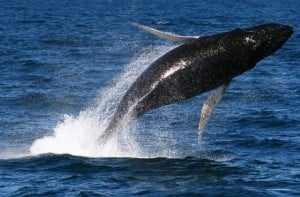Pipeline politics didn’t play into change in whale’s status: scientist
North Pacific humpback whale had nothing to do with Northern Gateway Project
Humpback Whale (nasmac/Flickr)
Share

The head of the committee of independent scientists that advises the federal government on endangered species says pipeline politics did not influence this week’s move by the government to change the designation of the North Pacific humpback whale from “threatened” to “species of special concern.”
Marty Leonard, a biology professor at Halifax’s Dalhousie University, and chair of the Committee on the Status of Endangered Wildlife in Canada, told Maclean’s the North Pacific humpback population has been steadily rising for years, and so it no longer qualified for the more serious “threatened” designation.
“It is based on extinction risk,” Leonard said of the change. “It’s based on the best science we had at the time. It’s not based on politics or any of that.” She explained that her committee conducted a reassessment of the humpback in 2011, and recommended the downgrade from threatened to “species of special concern.”
New evidence was later brought forward that might have prompted the whales to be divided into two separate populations, raising the possibility that one of those units might remain threatened, but the committee ultimately rejected that argument late last year.
“We reviewed the proposal that there were two distinct units, and we concluded based on a thorough review that there was not sufficient evidence at this point to split [the population] in two, and we stood by our advice of 2011,” Leonard said.
The timing of the change in the North Pacific humpback’s status makes the move extremely sensitive. If the government approves the controversial proposed Northern Gateway pipeline across B.C., then oil tanker traffic along the province’s rugged northern coastline would be needed to ship the oil from a new port to Asian markets. The tankers would have to pass through the humpbacks’ habitat.
Leonard said that under the federal law protecting species at risk, the treatment of those listed as threatened, including protection of where they live, is more stringent than what’s required for a “species of special concern.”
“If it’s threatened, there’s this thing called a ‘recovery strategy’ that’s prepared; critical habitat has to be identified and protected. If it’s ‘special concern,’ that doesn’t have to happen. A management plan has to be prepared, but it’s not as tight,” she said.
Still, she stressed that the change in designation does not mean the government can simply ignore the humpbacks. “Special concern is still a risk category,” Leonard said. “There’s still a management plan that’s prepared for species of special concern, so it’s not as if everything just stops.